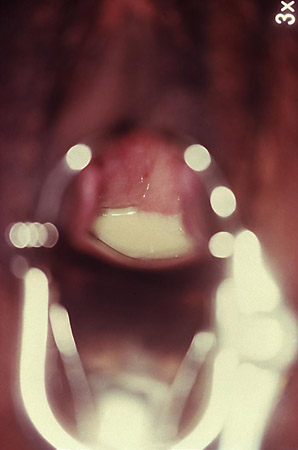History and exam
Key diagnostic factors
common
presence of risk factors
Strong risk factors include: douching; poor or excessive hygiene; prior antibiotic use; HIV infection; diabetes; black women; presence of IUD; use of the oral contraceptive pill; women of reproductive age; menopause; and sexual activity.
vaginal discharge
Colour, odour, consistency, frequency, and amount are all important factors in diagnosing the cause.
Commonly, discharge is white, thick, cottage cheese-like, and odourless in Candida infections; thin, malodorous, and white in bacterial vaginosis; thin/thick, green, yellow, or white, frothy, and odorous in trichomoniasis. [Figure caption and citation for the preceding image starts]: Trichomonas vaginitis with copious purulent discharge emanating from the cervical osCDC Image Library [Citation ends].
dysuria
Associated with candidiasis and trichomoniasis. Also associated with atrophic vaginitis.
discharge adherent to vaginal mucosa
White-to-grey discharge adherent to the vaginal mucosa in bacterial vaginosis; thick, white, cottage cheese-like discharge adherent to lateral vaginal walls in candidiasis.
Other diagnostic factors
common
prior episodes
May increase risk of future episodes, but does not help in distinguishing a particular aetiological factor.
pruritus
Associated with bacterial vaginosis, candidiasis, and trichomoniasis.
Also a common complaint in allergic or irritant causes of vaginitis.
vulvodynia
A common complaint in women with allergic or irritant vaginitis.
vaginal dryness
Associated commonly with atrophic vaginitis.
dyspareunia
Commonly associated with atrophic vaginitis and candidiasis.
A general presenting symptom for most types of vaginitis.
erythema
Commonly present in candidiasis and allergic or irritant vaginitis.
pale epithelium
Atrophy in atrophic vaginitis results in diminished capillary blood supply and the epithelium appears pale.
shiny epithelium
Thinning epithelium in atrophic vaginitis typically has a shiny appearance.
decreased elasticity
Skin looks dry and there is loss of turgor in atrophic vaginitis.
friable epithelium
May be noted on insertion of speculum in women with atrophic vaginitis.
uncommon
fever
Very uncommon; not necessarily indicative of severity.
Possibly more common with trichomoniasis since it is related to other STIs.
vaginal bleeding
May occur from cervicitis associated with trichomoniasis. Vaginal bleeding in atrophic vaginitis is rare, although can be related to vaginal dryness.
abdominal pain
Abdominal pain is a very rare presenting symptom, but may occur in association with pelvic inflammatory disease due to concomitant STI.
strawberry cervix
On inspection, the cervix may have a punctate and papilliform appearance in trichomoniasis.
Risk factors
strong
douching
May alter the flora micro-environment of the vagina, due to changes in pH.[1]
poor or excessive hygiene
Personal hygiene may affect the microflora of the vagina, for example poor hygiene might result from lack of access to medical services or sanitary products.[13]
antibiotic use
Recent course of antibiotics may precipitate vaginitis, especially candidiasis. Results in an imbalance in vaginal flora.[14]
change in feminine hygiene products and/or soap
May be suggestive of irritant/allergic aetiology.
HIV infection
Immunosuppression, particularly low CD4 count and high HIV viral load, is associated with vulvovaginal candidiasis.[15]
diabetes
There is a direct correlation between hyperglycaemia and incidence of vaginitis, particularly caused by Candida albicans.[16]
black women
Vulvovaginal candidiasis may be more common in this population.[7] Unclear reason for race predilection.
intrauterine device
May alter the flora micro-environment of the vagina.[17]
oral contraceptive pill use
Alters the hormonal balance and, therefore, the flora of the micro-environment. Associated with increased risk of vulvovaginal candidiasis infection.
latex condom/diaphragm
Allergic vaginitis may present in women allergic to latex.
reproductive age
Infective vaginitis is more common in these women.
menopause
Reduced oestrogen levels alter elasticity and pH of vagina, predisposing to atrophic vaginitis.[8]
multiple or new sex partners
Number of sexual partners and history of sexually transmitted diseases are key factors. Bacterial vaginosis is associated with having multiple male sex partners, female sex partners, sexual relationships with more than one partner or a new sex partner.[4]
Use of this content is subject to our disclaimer